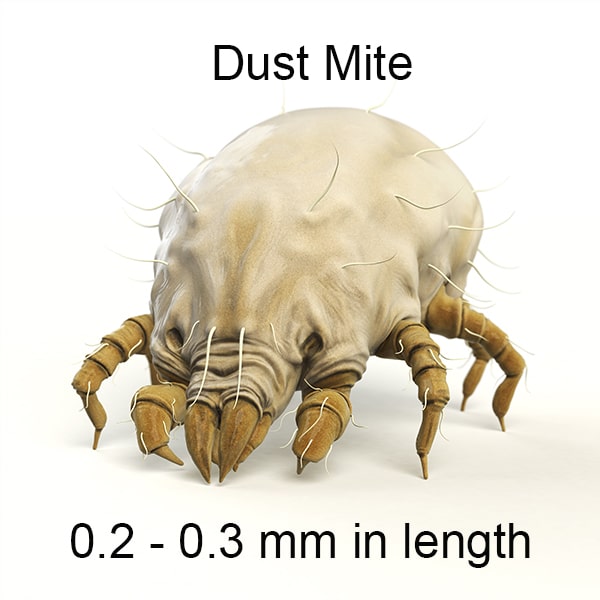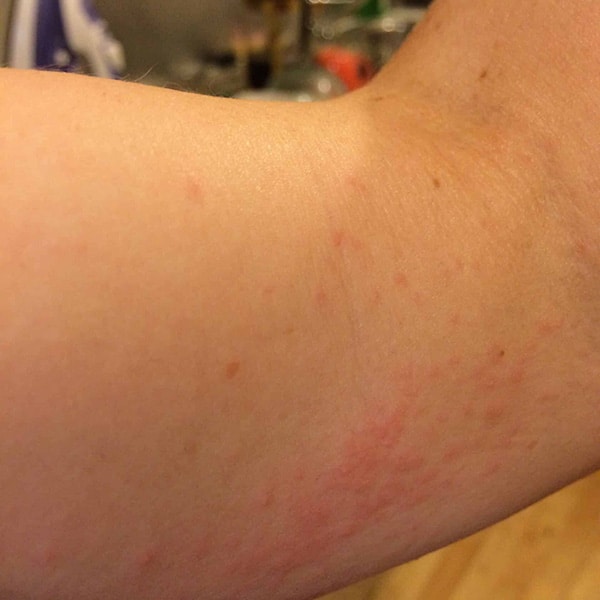
In the article
What Are House Dust Mites?
House dust mites are microscopic insects that feed on dust in the house. The main ingredient of dust is shed skin flakes, which serve as the favourite food source for dust mites.
Heavily used areas in the home, such as sleeping areas and upholstered furniture, will have more dust mites than the rest of the home.
The most common dust mite in Australia prefers coastal areas rather than inland. These dust mites have been associated with skin and breathing allergies in people, including eczema and asthma. There is not a single particular sign that house dust mites trigger a person’s allergies. Asthma can be caused by indoor allergens such as fungi (moulds) or animal dander (hair, fur, or feathers).
Dust Mite Allergic Reactions
House dust mites can trigger breathing issues and skin conditions, including asthma and eczema.
10 Signs & Symptoms of a house dust mite allergy:
- Coughing
- wheezing
- breathlessness
- a tight feeling in the chest
- runny nose
- itchy nose
- red, itchy, watery eyes
- difficultly breathing
- itchy skin
- rashes.

House Dust Mite Skin Rash
What Do House Dust Mites Look Like
The main characteristics of house dust mites include:
- They are microscopic and can’t be seen with the naked eye.
- they don’t have wings
- oval-shaped body with six legs
- light-coloured body with fine stripes
- the life span of approximately two months.

House Dust Mite Bites
Allergic Reactions To House Dust Mites
Unlike other common household bugs like bed bugs and fleas, dust mites don’t bite. Their bodies and faecal excretions contain a particular protein that may trigger allergic reactions in some people.
Where D0 House Dust Mites Hide
They prefer warm, humid and dark environments. Common hiding spots in the home include:
- bedding – sheets, mattresses, duvets and pillows
- upholstered furniture
- carpets
- soft toys
- curtains
Diagnosis and Treatment for House Dust Mite Allergies
- Allergy testing can determine whether house dust mites trigger your respiratory or dermatological symptoms. See your doctor for further information and advice regarding evidence-based allergy tests.
- If tests show that you are allergic, there are ways to reduce your body’s immune system response. For example, you could undergo allergen immunotherapy, which involves deliberately exposing you to dust mite extracts to ‘train’ your immune system not to overreact.
- Measures designed to reduce your household’s dust mite population may also be helpful.
How To Reduce The Dust Mites In Your Home
It is impossible to destroy your dust mite population, but you can reduce their numbers. The fewer dust mites you have in your home, the less you may be troubled by respiratory or dermatological symptoms.
It is important to remember that the droppings of dead dust mites continue to provoke allergic reactions. You must reduce the dust mite population and take steps to remove their dead bodies and faeces from your home.
Allergy reduction methods include:
- Cover mattresses, pillows and quilts with dust-mite-proof bedding. The covers should be washed every two months.
- Wash bedding weekly in hot water.
- Tumble dry on hot or dry clean household items.
- Wash blankets and non-encased donnas every eight weeks.
- Use washable donnas and pillows.
- Avoid sheepskin underlays and any other sheepskin products.
- Remove soft toys from the bedroom and replace them with toys that can be washed. Soft toys should be washed often to remove allergens.
- Clean surfaces weekly and avoid using a duster.
- Reduce humidity – have a well-ventilated house.
- Avoid curtains – Plastic Venetian or wooden blinds are the best; avoid fabric curtains.
- Where possible, remove carpets, rugs and mats
- Wash rugs and mats often and dry them on hot.
- Vacuum weekly
- Use a dust mite steamer to quickly kill mites
House Dust Mites Covers For Couch Seats And Dog Beds
Treatments That Don’t Work Well
Some treatments that claim to reduce dust mite populations have little or no benefit, including:
- chemical sprays
- air filters
- electric blankets
- negative ion generators
- allergen-free products
House Dust Mite Resistant Bedding
Mattress Covers
If you’re looking to keep dust mites out of your mattress, dust mite-resistant covers are a must. These covers wrap around your entire mattress, creating a solid barrier that keeps those pesky mites from getting in and making themselves at home. By stopping them from reaching the dead skin cells they love, these covers help you breathe easier and sleep better.
Duvet Covers
Your duvet deserves protection too, and dust mite-resistant duvet covers are up to the task. These covers are tightly woven to keep dust mites from sneaking in and setting up shop. By using one, you’re taking a simple but effective step to keep your duvet clean and allergen-free.
Pillow Covers
Pillows can be a hotspot for dust mites, but with dust mite-resistant pillow covers, you can keep them at bay. These covers completely encase your pillows, preventing mites from burrowing in and causing trouble. It’s a small change that can make a big difference in your comfort and health.
Frequently Asked Questions:
- How to get rid of house dustmites in your home?
Lower your home’s humidity below 50% using a dehumidifier or air conditioning. Wash your bedding in hot water weekly. Vacuum regularly with a HEPA-filter vacuum. Use dust mite covers on mattresses, duvets and pillows, declutter your space, and consider hard flooring instead of carpets. - Do dust mites live in blankets?
Yes, dust mites can live in blankets. They thrive in humid, warm environments where they feed on dead skin cells. Regularly washing blankets in hot water is key to reducing dust mites. - Can dust mite allergy go away?
Dust mite allergies may not completely go away, but they can be managed. Over time, symptoms might lessen with consistent allergen avoidance and treatment, such as antihistamines, decongestants, or allergy shots. Environmental controls like cleaning and reducing exposure to mites can also help alleviate symptoms.
If you have enjoyed our blog “house dust mites” then you might like to check out our dust mite product page.
What Our Tv Commercial From 2005 on the Kerry Anne Show
We have been selling house dust mites products including mattress covers, duvet covers, pillow covers and dog bed covers for dust mites and their allergies for two decades.
Sources:
Better Health (mould and your health), NCBI (dust mites), Cleveland Clinic (dust mite allergy)



Leave a Reply